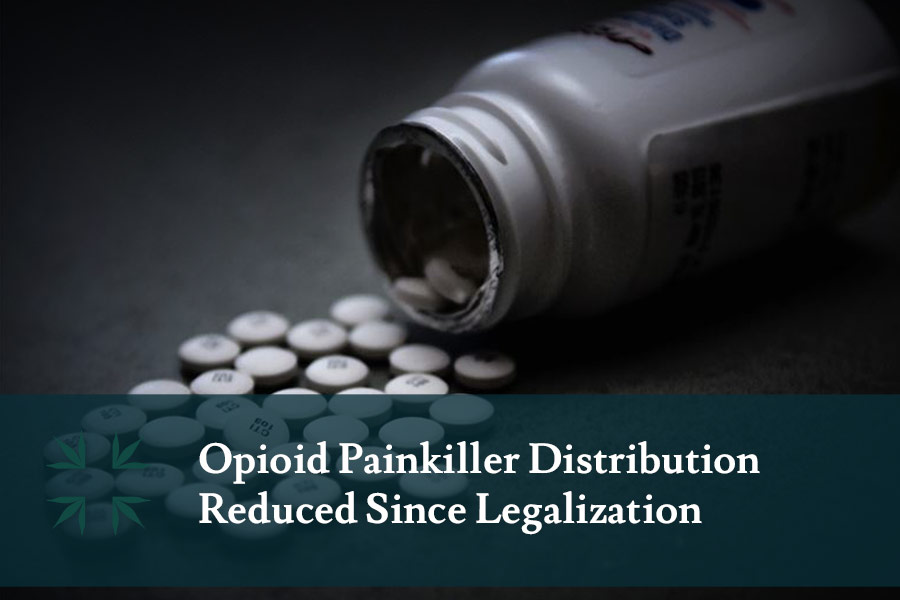Access to legal adult-use marijuana may lead to fewer pain-relieving opioid prescriptions, according to a recent study.
While there is extensive research evidence showing a link between medical marijuana access and lower opioid use, studies considering the impact of fully legalized marijuana systems on opioid prescription rates are few and far between.
To help fill this gap, researchers from Geisinger Commonwealth School of Medicine and the University of New England decided to look at the experiences of Colorado, where adult-use cannabis has been legal since 2012.
For comparison, the researchers included Utah and Maryland, where adult-use cannabis remains illegal. These states were also chosen because of their demographic similarities to Colorado, in terms of population size, education levels and uninsured rates.
For each of the three states, the researchers analyzed data from the U.S. Drug Enforcement Administration (DEA) on the distribution of nine opioid pain medications between 2007 and 2017. They also looked at the distribution of two drugs used to treat opioid use disorder (OUD).
Maryland distributed the largest amount of prescription painkiller during the study period by far. It peaked at 12,167 kg of morphine milligram equivalents (MME) in 2011, compared to 5,029 kg MME in Colorado in 2012, and 3,428 kg MME in Utah in 2015.
After looking at the trends over time, the researchers found that since legalizing cannabis in 2012, the distribution of prescription painkillers in Colorado has dropped by almost 12 percent.
Utah saw an increase of almost 10 percent over the same period. In Maryland, pain medication distribution fell by 6 percent, but it is worth noting that the distribution of medications used to treat OUD increased by more than 66 percent.
“Colorado and Maryland experienced an overall decrease in opioid distribution, but Colorado’s decrease was larger,” the study states. “While the nation as a whole was experiencing a decrease in opioid distribution, it was promising that Colorado’s greater decrease gives consideration to the potential impact of recreational marijuana.”
Their findings led the researchers to conclude that “marijuana could be considered as an alternative treatment for chronic pain and reducing use of opioids.”
Further, they suggest that legal adult-use marijuana could lead to a reduction in opioid abuse.
“If there is an initial reduction in opioid distributions in states with recreational marijuana laws, it is conceivable that opioid misuse, addiction, and overdose deaths could also fall,” the study’s authors wrote.
One of the policy implications of this, according to the researchers, could be to “reconsider the practice of automatically discharging patients from pain treatment centers for positive marijuana screens, considering this use might actually reduce their overall opioid use.”
The study’s authors acknowledge limitations to their research method, which means that other variables or layers of analysis have not been included that could affect the interpretation of the results.
Maryland passed a law allowing medical cannabis in 2013, but Utah only approved medical marijuana in 2018 following a voter ballot.
The researchers also didn’t consider the impact of related state-level public health policies. Nor did they look at changes in prescription rates at a pharmacy or individual level, which could indicate more decisively whether a patient switches from opioid painkillers to adult-use marijuana.
But it is not a great stretch of the imagination to think that the availability of adult-use cannabis in Colorado has led to a decrease in opioid prescriptions. This is especially so when considered alongside other studies, such as Pills to Pot: Observational Analyses of Cannabis Substitution Among Medical Cannabis Users With Chronic Pain and Medical cannabis patterns of use and substitution for opioids & other pharmaceutical drugs, alcohol, tobacco, and illicit substances; results from a cross-sectional survey of authorized patients, which have yielded similar results with regards to medical marijuana, and yet more which have found that many adults self-medicate with marijuana at recreational dispensaries.

Leave A Comment